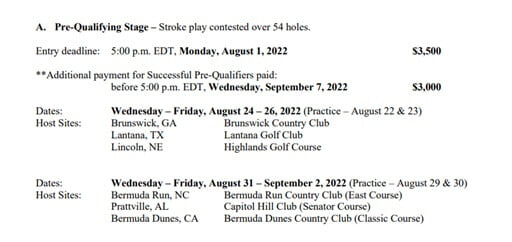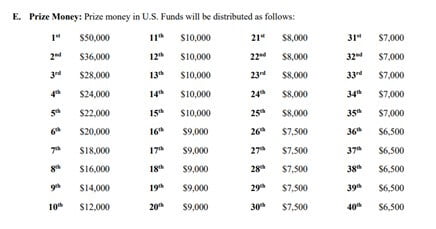
This page uses affiliate links. When you click an affiliate link, we get a small compensation at no cost to you. See Our Affiliate Policy for more info.
Since the Phil frenzy back in March surrounding Mickelson’s potential involvement with LIV Golf, the floodgates have opened with a slew of Tour Pros jumping ship to the Saudi-backed Tour. Bryson, DJ and now Brooks Koepka are among the 26 pros committed to LIV Golf and there’s good odds that number will grow. After all, with three-day events, no cuts and purses well beyond PGA standards, it’s an offer well worth consideration. Which makes one ask, how expensive is golf?
The PGA has been steadfast in making an example out of defectors by suspending them from the Tour indefinitely. ‘Unbiased’ articles from the likes of Golf Digest will give you every reason why this new threat – ahem, Tour – is a detriment to the sport. Character, critics say, is thrown out the window at the behest of “money, baby (plus, in some cases, allegedly being mad about video rights or something, but mostly money)”. Heartstrings pulled, fans shall weep as their once beloved brotherhood of players disbands. But as someone who has followed all forms of professional golf, and who has seen the sacrifice these athletes make for a chance to play at an elite level, I believe that this PGA dam was meant to break.
How expensive is golf for the average golfer? The reality is that golf ain’t cheap. Iron sets near a grand. A new driver runs upwards of $500. Don’t forget the bag to hold it all! Then, there’s the equipment – balls, tees, gloves, bags. And of course, lessons, round fees and a tip for the caddy. According to a 2009 Golf Magazine survey, the cost of playing for fun will run the average player $2,776 per year (which has undoubtedly increased over the past decade). Learn more how much are golf lessons here.
For a playing professional who’s trying to make it, these are just starting costs. Unless a pro has garnered enough attention to gain corporate sponsorship, he’ll still foot the bill for all his equipment, clothes, lessons, and tournaments. How expensive is golf? From personal experience booking mini-Tour events, I know that the average cost per event runs around $1,800 between entry fees, travel, lodging and food. To have a competitive go, up and-comers can easily shell out 20 grand per season.
While promising amateurs or those with a couple of strong finishes under their belt may enjoy a few freebies and modest sponsorship, most are investing in a career they only hope to see to fruition.
Indeed, before players even make it to the Korn Ferry or PGA Tours, they dump thousands upon thousands of dollars every year for the opportunity. The yearly four-stage qualifier known as Q-School extends Korn Ferry membership to a select few who make it to the final round of qualifying. Exactly how expensive is golf for these players?
Last year, the Pre-Qualifying Stage was a steep $2,700 and the PGA just raised prices for entry to a whopping $3,500. Those who make it through this initial round are not in the clear, either. Subsequent rounds skyrocket in price, with First Stage coming in at $6,500, Second Stage, $6,000, and Final Stage a gut-wrenching $5,500.


Prize money for the Final Stage awards first place $50,000. But with each player dropping $21,500 to get to this point, only the top five finishers will make a profit. That means that the other 35 players in this round, plus the hundreds of guys who missed prior cuts, are losing money. On top of that, players who earn their Korn Ferry card will still need to plan to cover the aforementioned tournament costs unless they catch the eye of a corporate philanthropist.
“What does this have to do with PGA Tour pros?” Well, the costs only inflate at the next level. Now, it’s imperative to have a reliable team surrounding you- not only your coach, but a caddy, physical therapist, trainer, manager, agent and so on. To pay each of these parties, to transport them from event to event, and to ensure they take care of all the background noise so the only thing you need to worry about is performing, is an expensive endeavor indeed.
Between traveling, taxes, club memberships and paying their team, it’s estimated that between 60 and 70 percent of players’ winnings will be wiped before it ever hits their bank account. Top players comfortably making millions each year may not bat an eye and even splurge on private chefs and charter flights (see Netjets for reference). The situation for those struggling to make the cut each week, though, is not so cushy.
Just how expensive is golf for the PGA pros? 2021’s median Tour earnings came in at $968,716. About 15% of pros earned less than six figures; Parker McLachlin rounded out the 250-player list with winnings of $6,090. Pros who finish last after making the cut on Friday can expect to earn around $25,000 for their efforts (before that 70% chunk is taken out).
Even after all of the financial sacrifice, players who finally make it to the highest level of this sport are still not guaranteed a payday. Making the cut doesn’t necessarily get you out of the red. Miss one too many cuts and you’ll lose the card you worked so hard for. There’s a lack of stability in golf, the likes of which are unseen in other professional sports.
The median MLB salary last year, for comparison, was $4,170,000. Once players graduate from AAA, they can expect a multi-year contract that pays a pretty penny. Take Seth Beer, for instance: he was last year’s lowest earner in the MLB, coming in at $570,500. The median salary in the NFL was $860,000. Most contracts for these leagues assure pay even if a player is injured, whereas Tour pros will simply get a medical exemption to keep their status through recovery. Not to mention, in a team sport, athletes don’t need to perform as consistently in order to make bank (the MLB is seeing its lowest batting average in history – .233). On top of salary, sports teams provide accessibility which Tour pros – considered independent contractors – need to secure on their own: flights, trainers, P.T., and coaching.
As yearly expenses eat at earnings, most players increase their net worth through sponsorship. Various companies endorse professional golfers, including clothing brands, auto manufacturers, and insurance firms (who else loves Rickie Fowler’s Farmers Insurance commercials?). Companies “will pay a player a premium to have its logo on their hat or the chest of their golf shirt, which is reported to run as high as $500,000.” According to GolfLink, Tiger earned shy of $200,000 in 2021 due to his accident, yet raked in $62 million for the year from his deals with Nike, Bridgestone, and others.
On that note, Tiger has impressively won over $120 million throughout his career – the highest in Tour history. Tiger recently became a billionaire. Yet as much as he dominated on Tour, 88% of his net worth comes from sponsors and endorsements off the course. Most players nowadays rely on their brand and image to close deals and boost their standing.
The PGA Tour is a business. And it benefits the consumer for a business to have competition. Just yesterday, in fact, the PGA announced eight new additions to their schedule for the 2023 season: limited field events with no-cuts and a handsome $160 million payout. Sounds familiar, hm? While PGA Commissioner Jay Monahan claims the Tour – and golf itself – are “under attack” (“how is this good for the game that we love?”), this author would wager such emotional smokescreens shield more monetary fears. They did not change how they determine the final pairings in golf however.
The creation of the LIV Tour places power in the hands of Tour pros, who will now have more than one avenue for their career. LIV Golf is not a hill to die on, but rather a door opening to a new era of golf possibilities. One with more tours, more choice and yes, let’s be real – more money. Maybe the day will come where players are salaried to cover the hefty costs of their career path. Maybe other qualifying schools will pop up, driving down the cost of entry fees. And maybe, most importantly, it will allow more youth the shot at this dream.
So yes, maybe the shortened 72-hole format offered by LIV Golf, maybe their $20 million purse with a guaranteed $120,000 just for showing up, is going to poach more players from the PGA. But to dismiss this leap as pure greed, knowing the grind and sacrifice needed to get to this stage, is foolish. These players are making a leap to advance their quality of life – and it’s a leap of faith that more should take.